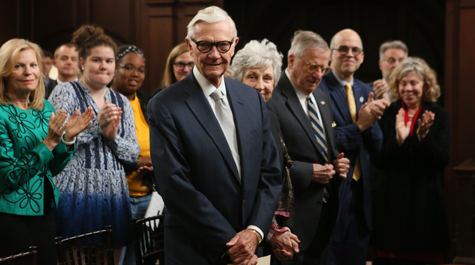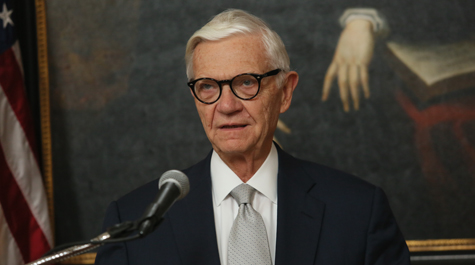W&M’s 27th president, Taylor Reveley, announces plans to retire in 2018
When Taylor Reveley took a long and unexpected walk from the William & Mary Law School to the Brafferton on Feb. 12, 2008, he came to a campus and alumni body in turmoil after the sudden resignation of Gene Nichol, the university’s 26th president. Reveley, who had served as dean of the law school for 10 years, was just named interim president.
Today William & Mary’s 27th president stood in the Great Hall of the Wren Building to say he would be retiring next year on June 30, 2018, after a decade leading the university. While noting there is much he still plans to get done over the next 14 months, Reveley recalled a time in which William & Mary has made enormous progress.
{{youtube:medium:left|hz_9C-oFPYs, Excerpts from Reveley's retirement announcement}}
“Serving as president of a college or university is one of the most challenging but meaningful jobs anyone can possibly have,” Reveley said. “It has certainly been so for me. And it has been a rare privilege to lead this magnificent school. All parts of the William & Mary family, working together, have taken crucially important steps forward. I’ll leave the Brafferton in June 2018 with confidence that W&M’s momentum will keep rolling, while I enjoy the Elysian Fields of retirement at long last.”
From reshaping the university’s physical footprint and reinvigorating William & Mary’s strategic planning process to reimagining the College’s undergraduate liberal arts curriculum and building a new financial foundation for the university, the Alma Mater of the Nation has moved ahead over the past decade. Along the way, William & Mary’s alumni engagement, philanthropic efforts and avenues of communication have reached new heights.
“Taylor has done a phenomenal job of leading William & Mary to a position of sustainable excellence,” said W&M Chancellor Robert Gates ’65, L.H.D. ’98, former U.S. Secretary of Defense. “The challenge as a leader in a hallowed institution like William & Mary is to honor the traditions that bind the Tribe together but still move the institution forward. The Reveley era will be judged by historians as a turning point for the university, during which we gained the facilities, financial model and processes that will drive William & Mary’s preeminence for years to come.”
Rector Todd A. Stottlemyer ’85 commented on the importance of Reveley’s steadying presence during challenging times, and the close working relationship with the administration the Board has enjoyed during his tenure.
“Every aspect of the university has advanced under Taylor’s leadership,” Stottlemyer said. “Today our finances are stronger thanks to the William & Mary Promise, our curriculum more versatile, our facilities ready to carry us into the 21st century, and our community increasingly diverse and united in a shared pride in William & Mary. From behind-the-scenes organizational changes to major public initiatives, Taylor has proven to be an outstanding leader, the ideal person for this chapter of William & Mary’s history.”
Stottlemyer said the Board of Visitors will announce next week appointments to a presidential search committee and more information about the process for selecting William & Mary’s 28th president.
Audacious goals
In February 2008, Reveley was in his 10th year as dean of the nation’s oldest law school when he was asked by then-Rector Michael K. Powell ’85 to serve as interim president. From his first day, Reveley was anything but an interim.
“The immediate need was to restore a campus environment in which faculty, students and staff could focus anew on doing their best work,” Reveley recalled. “Simultaneously, we needed to regain the confidence and support of the alumni body, while removing William & Mary from the jaws of the media and state politics.”
By the end of that spring semester, his impact was evident. In September 2008, the “interim” tag was removed and Reveley officially became W&M’s 27th president.
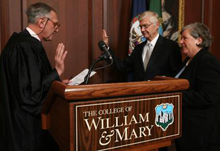 In the decade since, Reveley has seen his early efforts reach fruition and accomplished more, guided by his “audacious goals.” He wanted William & Mary first among public universities in undergraduate education, graduation and retention rates, and alumni giving.
In the decade since, Reveley has seen his early efforts reach fruition and accomplished more, guided by his “audacious goals.” He wanted William & Mary first among public universities in undergraduate education, graduation and retention rates, and alumni giving.
The campus has been physically transformed since 2008. New facilities, funded by both public and private funds, include the new School of Education, new Business School and three phases of the Integrated Science Center. All told, more than 1.5 million square feet — over 40 percent of campus — will have been built or renovated on the main campus and at VIMS by the close of 2018.
The campus also expanded under Reveley with William & Mary’s 2013 purchase of the Hospitality House, now One Tribe Place, adding 3.7 acres to the campus and providing additional housing and parking for students. The William & Mary Real Estate Foundation, meanwhile, built Tribe Square and purchased the Days Inn (soon-to-be Richmond Hall), adding both residential and restaurant options.
Under Reveley, William & Mary has worked to cement its standing as the national leader in liberal arts education. In September 2015, William & Mary launched the new College Curriculum, or COLL. It was the result of several years of work by faculty to replace a general education curriculum that had not been revised in almost 20 years. Comprising about a quarter of undergraduate credits, COLL courses emphasize rigorous thought, research, effective writing and speaking, interdisciplinary connections and global understanding, and they culminate in a capstone experience.
William & Mary is also incorporating engineering and applied design concepts into the curriculum through a new set of programs. The project includes a proposal for a data science minor (and later, a major), which would offer computational and analytical skills and techniques to a wider group of students. Another component includes an engineering physics degree designed for physics majors who go directly into industry or start their own enterprises. That curriculum would retain a solid background in math and science while adding classes in practical areas, such as design, simulation and business.
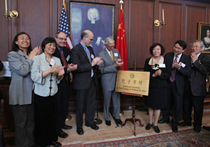 During the past decade William & Mary has renewed its sense of international excellence. It consistently leads the nation’s public universities in terms of students studying abroad, with roughly 50 percent of undergraduates studying overseas during their years at William & Mary. Over the past decade, William & Mary has tripled the number of international students and scholars on campus. In 2010, William & Mary launched a joint degree with the University of St Andrews, one of only a few such programs in the world. The following year, W&M announced the creation of the Confucius Institute in cooperation with Beijing Normal University. In recognition of these efforts as well as curricular requirements and a wealth of study-abroad and study-away opportunities, William & Mary was honored in 2016 with the Senator Paul Simon Award for Comprehensive Internationalization.
During the past decade William & Mary has renewed its sense of international excellence. It consistently leads the nation’s public universities in terms of students studying abroad, with roughly 50 percent of undergraduates studying overseas during their years at William & Mary. Over the past decade, William & Mary has tripled the number of international students and scholars on campus. In 2010, William & Mary launched a joint degree with the University of St Andrews, one of only a few such programs in the world. The following year, W&M announced the creation of the Confucius Institute in cooperation with Beijing Normal University. In recognition of these efforts as well as curricular requirements and a wealth of study-abroad and study-away opportunities, William & Mary was honored in 2016 with the Senator Paul Simon Award for Comprehensive Internationalization.
The university also continues to incorporate technology in the classroom without sacrificing its trademark faculty-student interaction. In 2012, the university established the Creative Adaptation Fund to encourage educational innovation. Many of its awardees have focused on eLearning initiatives, including designing virtual labs, interactive modules to complement lectures, online course prerequisites and summer professional development programs. In 2015, the Raymond A. Mason School of Business launched William & Mary’s first all-digital degree program in an online MBA.
Intercollegiate athletics thrived during the Reveley presidency, during which William & Mary strengthened its tradition of encouraging athletes who are both powerful competitors in their sports and strong students who graduate on time. William & Mary remained a school “that does athletics right.” During his years of leadership, 40 students were selected as Colonial Athletic Association scholar-athletes, leading the league. At the same time, W&M’s teams won 44 CAA and Eastern College Athletic Conference championships, and 33 teams participated in NCAA championships. W&M also boasted 66 athletes who won all-American honors.
In 2015, William & Mary’s Committee on Competitive Excellence, appointed by Reveley, released a roadmap to provide a “championship experience for every student-athlete and every fan.” The planning report outlined a vision for the future of athletics at W&M and how to best and strategically leverage limited resources for excellence. The report also considered how to attain greater success in the CAA, boost W&M’s national recognition, fund athletic scholarship needs, tackle facility improvements and improve the game-day experience for fans.
Financing for the future
From his first days as president, Reveley began delivering a message of self-reliance, emphasizing the need for a new financial foundation — one less dependent on state support — to secure William & Mary’s future. To that end and in support of the university’s new strategic plan, William & Mary increased efficiencies on campus to cut and curb costs, expanded philanthropic engagement by alumni and friends, adjusted tuition to reflect the quality of the university’s education and increased financial aid for students with need.
The William & Mary Promise, adopted by the Board in 2013, was key to the new financial model. Designed to create tuition predictability for in-state undergraduates, ensure affordability for low- and middle-income families and generate new revenue, the W&M Promise guaranteed in-state undergraduate tuition for four years and substantially increased need-based financial aid. Since inception of the W&M Promise, the average net price for Virginia families making less than $75,000 has dropped by more than 20 percent, and the university consistently ranks as one of the lowest public institutions in Virginia in terms of net price for in-state students who qualify for aid.
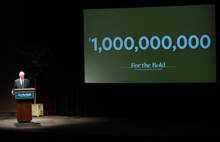 The stability created by the additional revenues generated by the Promise allowed Reveley to invest in faculty salaries, which had lagged for years behind W&M’s peer group as defined by the State Council for Higher Education in Virginia.
The stability created by the additional revenues generated by the Promise allowed Reveley to invest in faculty salaries, which had lagged for years behind W&M’s peer group as defined by the State Council for Higher Education in Virginia.
“What Taylor has accomplished is truly remarkable,” Stottlemyer said. “He wasted no time bemoaning William & Mary’s finances, but instead directed all of his efforts — all of our efforts — toward securing a new model under which the university could thrive. He aligned the administration, the Board and ultimately the state in order to successfully implement the Promise.”
Reveley also led a renewed focus on philanthropy. During his time as president, he has overseen unprecedented levels of giving.
Before Reveley, William & Mary raised more than $100 million only once, in 2005. Today, raising at least $100 million annually is the new normal, with W&M hitting the goal for the past four years. Fiscal 2016 saw giving top $140 million.
William & Mary started celebrating One Tribe One Day, the annual day of giving, in 2014. The first year, One Tribe One Day recruited roughly 1,700 donors, more than any other single 24-hour-period in its history. Subsequent years yielded stunning results. In 2015, more than 6,000 donors participated. That number grew to more than 10,000 in 2016. Last month, William & Mary once again set a record for most donations within a 24-hour period when more than 12,600 people took part in the annual day of giving.
For the Bold, a $1 billion campaign, began in 2015. William & Mary is the smallest public university, the only public with less than 100,000 alumni, to undertake a campaign of that magnitude. To date, the university had raised nearly $700 million. In addition, For the Bold seeks to increase alumni engagement and reach 40 percent undergraduate alumni participation in annual giving, a rate that would rank among the top handful of U.S. universities, public or private, putting W&M behind only Princeton, Dartmouth and Notre Dame among leading universities.
“Taylor led an important change in the way we thought about and approached engagement and philanthropy,” said Sue Gerdelman ’76, secretary of the Board of Visitors and campaign chair. “He emphasized the importance of every gift, no matter the size, as a vote for alma mater and he does a fantastic job explaining why every dollar given to the university makes a difference. The William & Mary community, ever loyal, has responded enthusiastically and come together in support of these ambitious goals.”
Caring for the Tribe
Reveley has worked diligently — often behind the scenes — to spur William & Mary to progress through a hands-on, inclusive and deliberate approach to delicate and important issues.
“Real leadership demands a strong moral compass to deal with the matter at hand, no matter the cost,” Gates said. “When issues arose, Taylor was ready to do the right thing for William & Mary.”
With a 2009 Board of Visitors resolution, the university launched the Lemon Project: A Journey of Reconciliation, a long-term research project devoted to facing rigorously William & Mary’s history of slavery and segregation. The project is named after an enslaved man known only as Lemon owned by the university in the early 18th century. In addition to research, the program hosts an annual symposium and is currently working on creating a campus memorial to the enslaved and free Africans and African-Americans who helped build and maintain William & Mary before the Civil War. The program has become a model for similar reconciliation efforts across higher education in America.
In 2015 Reveley ordered removal of the Confederate battle flag from two areas of campus. A memorial plaque in the Wren Building listing only those students and faculty who left W&M to fight for the Confederacy was placed in Swem Library’s Special Collections. The flag and Seal of the Confederacy were also removed from the College Mace. But Reveley also insisted that William & Mary not forget its history. A new Wren plaque will honor all those from W&M who fought in the Civil War, on either side, thus adding more names to the walls of the Wren. The mace now displays an emblem that is an adaptation of an 1863 illustration of the Wren Yard during a Civil War battle in Williamsburg.
Also part of William & Mary’s history is the student-administered honor system, which dates to at least 1736. At Reveley’s request, the Honor Code — the system through which the university’s Honor Pledge, which has not changed, is enforced — underwent a substantial review. In 2013, with presidential approval, a revised code provided clarified definitions, a new early resolution process under certain circumstances, more tailored sanction guidelines and an Honor System Advisory Committee to ensure the code remains accessible and readily utilized by faculty and students.
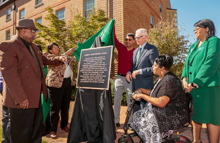 Reveley also formed task forces and working groups to address challenging issues facing campuses nationwide. In 2015, Reveley charged a working group to identify ways William & Mary can improve its support for students who are veterans or active duty. Recent task forces on sexual violence and harassment and on race relations also produced comprehensive reports that led to immediate and significant changes on campus. In the fall of 2016, for example, W&M dedicated its first two buildings named for people of color. The Jamestown Road dorms now honor Lemon, the enslaved man owned by William & Mary, and Carroll F.S. Hardy, a longtime administrator who measurably increased diversity at the university.
Reveley also formed task forces and working groups to address challenging issues facing campuses nationwide. In 2015, Reveley charged a working group to identify ways William & Mary can improve its support for students who are veterans or active duty. Recent task forces on sexual violence and harassment and on race relations also produced comprehensive reports that led to immediate and significant changes on campus. In the fall of 2016, for example, W&M dedicated its first two buildings named for people of color. The Jamestown Road dorms now honor Lemon, the enslaved man owned by William & Mary, and Carroll F.S. Hardy, a longtime administrator who measurably increased diversity at the university.
English Professor Suzanne Raitt worked closely with Reveley as both a Faculty Assembly president and the faculty representative for two years on the Board of Visitors. She cited his support for the new liberal arts curriculum, and efforts to address mental health issues on campus, as a few of many examples of Reveley’s advocacy for students, faculty and staff.
“President Reveley has put the well-being of our community and the pursuit of academic excellence at the heart of his agenda,” Raitt said. “His kind, unassuming presence has guided us through some of the College’s most difficult days. When he does leave William & Mary, it will be immeasurably stronger because of the work he has done for us all.”
Eboni Brown ’17 was Student Assembly president from 2016 to 2017 and worked as an orientation aide and orientation aide director.
“Incoming freshman students can be overwhelmed by moving to campus and starting at William & Mary,” Brown said. “From their first day on campus, President Reveley always tried to put them at ease, telling new students to take their time getting acclimated and not take on too much too soon. Academic rigor is important, but he never fails to remind us – freshmen, seniors or grad students – to slow down. He clearly wants us to take care of ourselves and one another as people, to maintain perspective and enjoy our college years.”
Looking ahead
At the April 7 ceremony, Reveley emphasized there is much unfinished business and many major projects and initiatives to advance in the coming months.
Later this year, William & Mary will kick off a yearlong effort to recognize the 50th anniversary of the first African-American residential students at the university. It is also planning for the 100th anniversary of women at W&M in 2018.
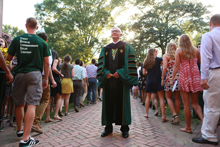 The university is renewing focus on the arts in two major projects. The Arts Quarter consists of a new music building, plus renovations and expansions of Phi Beta Kappa Hall and Andrews Hall. The new Martha Wren Briggs Center for the Visual Arts will also expand the Muscarelle Museum of Art.
The university is renewing focus on the arts in two major projects. The Arts Quarter consists of a new music building, plus renovations and expansions of Phi Beta Kappa Hall and Andrews Hall. The new Martha Wren Briggs Center for the Visual Arts will also expand the Muscarelle Museum of Art.
A number of other building projects are underway or are in the planning stages, including the McLeod Tyler Wellness Center, the fourth phase of the Integrated Science Center and renovations to Landrum Hall. At VIMS, new facilities include the Consolidated Scientific Research Facility, a facilities management building and an oyster hatchery.
William & Mary is also considering how the campus can improve to become more accessible to students, faculty members, staff and visitors with physical disabilities. Reveley named a task force on accessibility earlier this spring.
After its launch in the fall of 2015, the implementation of the COLL Curriculum continues, with the Class of 2019 looking toward the last two years of undergraduate study, which require an international or cross-cultural educational experience and a capstone course that allows that to develop original research or scholarly work.
By many measures, Reveley said, the university is advancing, thriving and is positioned for great success in the future.
“In my judgment, the 21st century is going to be the most productive and successful in William & Mary’s long life,” Reveley said. “The College, the university, is going to do great good for generations of William & Mary people in the years ahead, for their communities, states and nations.”
 Skip to main content
Skip to main content

